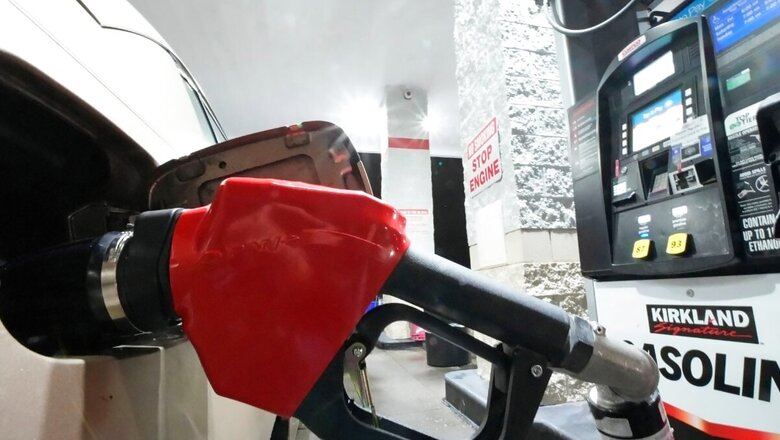
views
Union Road Transport and Highways Minister Nitin Gadkari on Tuesday unveiled a 100 percent ethanol-fueled variant of Toyota’s Innova car.
Gadkari launched Toyota Innova car on 100 percent ethanol, making it the world’s first car to run entirely on ethanol.
Gadkari said that he started taking interest in biofuels in 2004 after the petrol price hike in the country and visited Brazil for this purpose. He added that biofuels can do wonders and save a lot of forex which is being spent on the import of petroleum.
First Ethanol-run Vehicle
Nitin Gadkari launched the electric flex-fuel Toyota Innova MPV, which is entirely fueled by ethanol, indicated by “E100”. The launch is in line with government’s push to decrease country’s dependency on imported petroleum.
According to Toyota, the ethanol-fueled variant of Toyota Innova will be the world’s first BS-VI (Stage-II) electrified flex-fuel vehicle. Ethanol is a renewable, domestically produced transportation fuel made from biomass such as corn or sugarcane.
The Union Minister, who has been encouraging automakers to come out with alternative fuel-powered and green vehicles, launched a hydrogen-powered car last year.
Ethanol Flex-fuel Fueled Cars in India
While the world is rapidly switching towards electric-only vehicles, India is evaluating ethanol powered vehicles apart from the electric powered vehicles. India has started working on ethanol flex-fuel vehicles, which are designed to run on more than one fuel.
The flex-fuel is generally gasoline like petroleum blended with either ethanol or methanol fuel, and both fuels are stored in the same common tank.
Today our dream has come true…!Launched India’s first Flexi-Fuel Strong Hybrid Electric Vehicles (FFV-SHEV) which would run on 100% petrol as well as 20 to 100% blended ethanol and electric powertain with… pic.twitter.com/QmsrnXD1Qx— Nitin Gadkari (@nitin_gadkari) October 11, 2022
The official name for flex-fuel is E-85 as it has 85 percent ethanol fuel and 15 percent gasoline or other hydrocarbon by volume.
During Auto Expo in January this year, several cars were showcased which could run on a blend of ethanol and petroleum.
Maruti Suzuki showcased the prototype of WagonR flex-fuel which can run on petrol-ethanol blend of 20 percent and 85 percent. Toyota also showcased the Corolla Altis flex fuel car.
Meanwhile, several motor bikes including Yamaha Fazer FZ-15, Bajaj Pulsar NS160 and Hero Glamour Xtec Flex-Fuel were showcased which can run on ethanol-blended petrol. The higher the amount of ethanol in petrol, the more than price of the fuel could come down.
The flex-fuel is believed to be cheaper than normal petrol or diesel as the government will have to spend less on oil imports. As per reports, India’s imports of petroleum, crude and petroleum products were estimated at a value of over 12 trillion Indian rupees in 2022.
However, the cost of flex-fuel cars will increase by Rs 18,000-25,000, according to a report in The Times of India.
Ethanol E85 Across the Globe
The earliest use of Ethanol E85 was first seen in the UK where Saab launched Saab 9-5 BioPower, a flex-fuel car in 2005. The car was capable of running on either a high-blend mixture of bioethanol and petrol (E85) or just petrol, without any adjustment required by the driver.
Following the launch, Morrisons supermarket opened first BioEthanol E85 filling pump in 2006 as a part of its position being the UK’s largest retailer of alternative fuels. However, in 2010 it announced closing all the filling pump.
In 2007, the US under George Bush pledged to reduce America’s dependence on oil with a 20 percent cut in petrol use and a switch to bio-fuels, primarily ethanol. In 2015, eight major manufacturers in the US were offering E85-compatible vehicles. However, as of now only Ford and General Motors are selling new flex-fuel vehicles and most of those models are limited to fleet sales as manufacturers have slowly drifted away from flex-fuel and moved towards EV.
However, ethanol was back in the news when in October 2021, King Charles displayed his Aston Martin, which could run on bioethanol, made from cheese and wine wastes. The car that Charles has owned for five decades was converted to run on a fuel blend made up of 85% bioethanol and 15% unleaded petrol.
Concerns over Ethanol blended fuel
India desperately wants to reduce dependence on imported crude oil, which is a problem for the country as it imports 85 percent of its crude oil. But it raises concerns over food security and water scarcity as food supplies will be diverted for ethanol production.
The ethanol fuel is powered by the sugarcane crop, which requires a lot of water. On an average, one tonne of sugarcane requires about 60-70 tons of water.
Going by the estimates, if the ethanol blend is 20 percent, then India would require 1,016 crore litres of ethanol in 2025. This would put pressure on the sugarcane production, which would seriously affect water supply as a huge amount of water would be required for its irrigation. Moreover, there is also a risk of the corrosion of the engine due to ethanol mixed fuels.




















Comments
0 comment